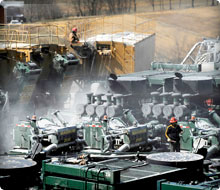Hydraulic Fracturing is used across the country to tap previously unreachable oil and natural gas locked within deep rock formations. It involves the injection of water, silica sand, and small amounts of chemicals into wells so that oil and/or natural gas can flow out of the well. A 2010 study by NIOSH found there are worker exposures that need to be managed during this process. In 2012 OSHA/NIOSH published aHazard Alert on ensuring workers in hydraulic fracturing operations have appropriate protection from silica exposure.
One of your first steps to determine if there are exposure issues is to perform personal air monitoring.
KEHS is pleased to announce that we can provide hydrofracking air monitoring services including but not limited to the following chemicals:
- Respirable Dust
- Silica Quartz
- Volatile Organic Compounds – Benzene, Toluene, Ethylbenzene, Xylene (BTEX)
- Hydrogen Sulfide (H2S)
- Noise
Optional / Additional Potential Hazards:
- Diesel Particulate
- Acid Gases (HCl)
- Aldehydes – such as glutaraldehyde
- Metals – such as lead

